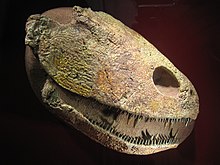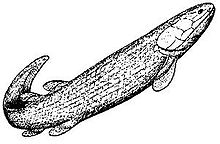Rhipidistia
| Rhipidistia | ||||||||||||
|---|---|---|---|---|---|---|---|---|---|---|---|---|
![Devonian Rhipidistier (and sister group Hohlstachler: Actinistier [Coelacanth])](https://upload.wikimedia.org/wikipedia/commons/thumb/d/db/Fishapods.jpg/300px-Fishapods.jpg)
Devonian Rhipidistier (and sister group Hohlstachler: Actinistier [Coelacanth]) |
||||||||||||
| Systematics | ||||||||||||
|
||||||||||||
| Scientific name | ||||||||||||
| Rhipidistia | ||||||||||||
| Cope , 1871 |
The Rhipidistia are traditionally a taxon of the Sarcopterygii (their sister group are the Actinistia , the "barbed fins" among the Sarcopterygii). Erik Jarvik defined them as Porolepi- + Osteolepiformes ; Today the Rhizodontida is mentioned as belonging, but not clearly attributable to the two mentioned orders.
features
Rhipidistia means: with a fan-shaped dorsal fin - an uncharacteristic feature. In contrast, the (hollow) rays of the anterior dorsal fin of the actinistia are intensified like spikes.
Hans-Peter Schultze (in Westheide and Rieger 2009) describes the Rhipidistia with the following features:
- Vomer with fangs.
- Plicidentin (the dentin of the teeth is crinkled in a characteristic way).
- The cranial bones have two tectalia on the front of the snout (between the prefrontal and premaxillary ), one post-plenial (and a total of four infradentalia: splenial, post-plenial, angular and surangular) and three coronoids in the lower jaw. By definition, choans do not occur in all rhipidistia.
Systematics

In strict cladist thinking, the Elpistostegalia (Panderichthyidae) and their sister group , the terrestrial vertebrates (Tetrapoda) belong to the Rhipidistia. As far as fish-like they lived from the Devonian to the Permian , but the lungfish (Dipnoi) (descendants of the Porolepiformes) also to this day.
The following diagram shows the possible relationships:
| Rhipidistia |
|
||||||||||||||||||||||||||||||||||||||||||||||||||||||||||||||||||||||||||||||||||||||||||||||||
|
|
literature
- W. Westheide, R. Rieger: Special Zoology. Vertebrates or skulls. Spektrum Akademischer Verlag, 2nd edition 2009 p. 319, ISBN 978-3827420398
Individual evidence
- ^ Brian Swartz: A Marine Stem-Tetrapod from the Devonian of Western North America. PLoS ONE 7, 2012, doi : 10.1371 / journal.pone.0033683
- ↑ Yu Xiaobo, Zhu Min & Zhao Wenjin: The Origin and Diversification of Osteichthyans and Sarcopterygians: Rare Chinese Fossil Findings Advance Research on Key Issues of Evolution. Bulletin of the Chinese Academy of Sciences, Paleoichthyology, Vol. 24 No. 2 2010
Web links
- Palæos.com: Rhipidistia
